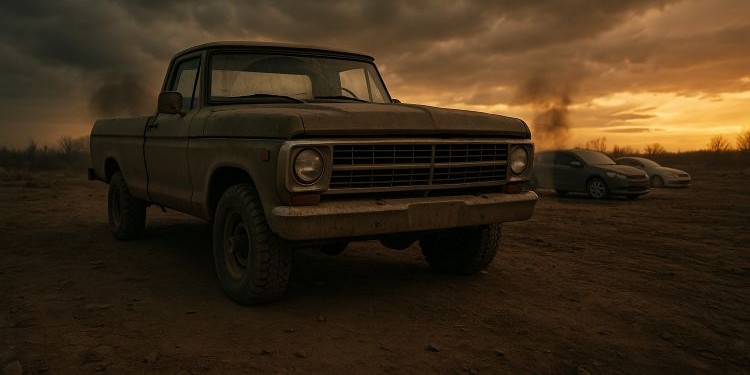How to Choose an EMP Proof Car for SHTF

Let’s start with the ugly truth: when the grid fries from an EMP, your shiny new SUV might as well be a $50,000 lawn ornament. Electronics are the Achilles’ heel of modern vehicles. Fuel injection, sensors, onboard computers, great for comfort, deadly for survival. When SHTF, the only cars that matter are the ones that still move when everything else grinds to a halt. So how do you pick the right EMP-proof ride? Let’s break it down.
Why Most Cars Will Die Instantly
Modern cars are built like glass castles—slick on the outside, fragile inside. Every system is tied to a chip, and an EMP pulse doesn’t discriminate. That touchscreen? Dead. The ignition? Dead. The computer brain under the hood? Dead. Think about it: if even one critical circuit fries, your escape vehicle just became a coffin on wheels.
Related: Is It Possible to Make Your Car EMP Proof?
The scariest part? You won’t even know it until it’s too late. You’ll turn the key, the engine will click, and nothing will happen. Meanwhile, highways will choke with abandoned cars as people realize their lifeline is gone. That’s the nightmare an EMP creates—instant immobility.
Related: The Worst Places to Be When an EMP Hits
And don’t think your insurance or roadside assistance will swoop in to save you. In a collapse, those services are dead in the water. Your mobility depends entirely on whether you prepared ahead of time. Choosing the right car is less about convenience and more about whether you live long enough to reach safety.
Go Back in Time: The Pre-1980 Rule
If you want a car that laughs in the face of EMPs, you need one that doesn’t rely on microchips. Pre-1980 vehicles—especially those with carburetors instead of electronic fuel injection—are your best bet. These machines are simple, mechanical, and brutal. No circuit boards. No fragile sensors. Just metal, fuel, and spark. Trucks from the ’60s and ’70s, old farm vehicles, even classic Jeeps—they’re EMP-proof by design because they were built before Big Tech had its claws in everything.
This isn’t nostalgia—it’s practicality. The less wiring a vehicle has, the less vulnerable it is. You can literally trace the ignition with your finger and see how it works. No “black box” mysteries, no dealer-only diagnostics. That simplicity is your shield when chaos erupts.
Of course, the trade-off is comfort. These older vehicles may not have air conditioning, power steering, or smooth rides. But when the alternative is being stranded on the highway with everyone else, sweating in an old steel tank doesn’t sound so bad. Survival doesn’t care if you’re comfortable—it cares if you’re moving.
Diesel Power: The Survivor’s Choice
Want bonus points? Look for an older diesel. Why? Diesels are simpler, tougher, and built for abuse. Many don’t even need an electrical system to keep running once started. Military trucks are legendary for this reason—they’ll still chug along long after everything else is silent. Plus, diesel fuel stores longer and burns steadier than gasoline, giving you more options when scavenging in a post-collapse world.
Another bonus with diesel is versatility. You can run some older diesels on alternative fuels—vegetable oil, heating oil, even homemade biodiesel. That flexibility turns scarcity into opportunity, giving you a chance to outlast those who depend solely on gas stations.
Related: 7 Things That You Should Never Do After An EMP
Let’s be honest: diesels are loud, heavy, and not the most graceful machines. But ask yourself—do you want quiet and sleek, or do you want a tank that keeps rolling when society crumbles? In the apocalypse, efficiency isn’t about miles per gallon. It’s about miles between burial plots.
Mechanical Ignition Systems
Electronic ignitions are like landmines waiting to blow up your survival plan. What you want is the old-school mechanical ignition: distributor caps, points, and coils. These parts are analog, EMP-resistant, and fixable with a wrench instead of a laptop. If your vehicle has them, you’ve already got a head start.
Think about the beauty of a mechanical ignition. If it fails, you can literally swap out the broken part in minutes with a spare. No software updates, no “check engine” light codes, no dependency on a corporate service center. Just good old-fashioned problem-solving.
That’s why seasoned preppers stockpile extras. Distributor caps and ignition coils are small, cheap, and life-saving. They don’t take much space, but they can be the difference between being mobile or stranded. EMP-proof vehicles are only as good as the person who can keep them alive.
Spare Parts = Insurance Policy
Even if you score the right vehicle, you’re not out of the woods. Stockpile spare parts now—alternators, ignition coils, fuel pumps, distributor caps. Keep them stored in a Faraday cage or even something as simple as an ammo can lined with insulation. When the pulse hits, you’ll have replacements ready while everyone else is panicking.
Imagine the difference: your neighbor’s truck dies, yours sputters, but you pop open your cage, grab a backup part, and you’re rolling again in an hour. That’s not luck—that’s foresight. Prepping is about stacking the odds in your favor before disaster strikes.
Related: DIY EMP-Proof Truck
Don’t forget consumables either—belts, hoses, filters, fluids. An EMP won’t destroy those, but the collapse will make them impossible to replace. What you have stocked before the event is all you’ll get afterward.
Key parts worth stashing:
Military Surplus: Built for War, Perfect for Collapse
If you can get your hands on a decommissioned military vehicle, congratulations—you’ve just won the survival lottery. Deuce-and-a-halfs, Humvees, old troop carriers… these things were designed to survive EMP-level warfare. They’re ugly, loud, and unstoppable. The government may write them off as scrap, but for you, they’re gold.
Military rigs come with benefits that civilian models can’t touch: rugged suspension, heavy-duty armor, and the ability to chew through terrain that would leave SUVs weeping. If you’ve ever seen one up close, you know they’re not built for luxury. They’re built for war—and war doesn’t care about comfort.
The catch? They drink fuel like it’s water, and they’re not exactly stealthy. But if you’re planning for bug-out scenarios or hauling a family through chaos, nothing else compares. You’ll have the backbone of a rolling fortress when everyone else is running on fumes.
Military rigs to watch for:
Final Thoughts: Don’t Be Fooled by Convenience
Choosing an EMP-proof car isn’t about comfort, speed, or style. It’s about survival. Strip away the gadgets, the touchscreens, the Bluetooth nonsense. What you need is raw mechanical resilience. Pre-1980, preferably diesel, preferably military. That’s the formula. While everyone else is stuck staring at their dead dashboards, you’ll be the one still moving, still surviving, still free.
The irony is that most people already know their shiny tech-heavy cars are fragile, but they convince themselves it won’t matter. That’s the trap—thinking tomorrow will look like today. If history proves anything, it’s that disaster doesn’t wait for permission.
If you’re serious about survival, start hunting now. Old cars are disappearing, and military surplus isn’t getting cheaper. The sooner you prepare, the sooner you guarantee mobility when the unprepared are left in the dust.
You may also like:
 How to Siphon Gas from a Car with Anti-Siphon
How to Siphon Gas from a Car with Anti-Siphon
Household Items You Need to Stock Up on Before SHTF (Video)
Never Store These Survival Items in Your Car
What Would an EMP Do to the Human Body?
99% (of Preppers) Won’t Survive an EMP Without This
Read the full article here









